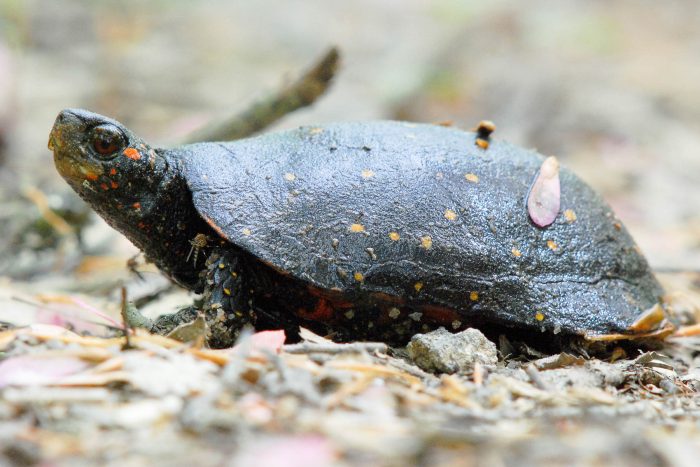Spotted Turtle
Clemmys guttata
The spotted turtle is a small semi-aquatic species known for the bright yellow spots that dot its dark shell. The species is listed as threatened in several states.
This section shows one large critter image at a time. Use the thumbnails that follow to select a specific image to display here.

This gallery contains a grid of small thumbnails. Selecting a thumbnail will change the main image in the preceding section.
Appearance
The spotted turtle is a small species that rarely grows larger than five inches in length. Its smooth carapace (shell) is slate gray or black with a variable number of bright yellow spots, which can disappear in older turtles. The plastron (underside of shell) is yellow or orange with wide black smudges.
Its head is mostly black with several bright yellow spots, and often a large yellow or orange blotch on each side. Its legs and tail are black with scattering of yellow spots. The lower surface of its legs and neck are orange to pink or salmon-red.
Males and females differ in size and coloring. Males have brown eyes; a tan, brown or black chin; and a longer and thicker tail. Females have orange eyes, a yellow or orange chin and a comparatively narrow tail.
Feeding
Feeding begins once spring temperatures reach about 60 degrees Fahrenheit. Spotted turtles feed on algae, soft aquatic plants, water lily seeds, worms, mollusks, crustaceans, insects and insect larvae, amphibian eggs and larvae and carrion.
Predators
Common predators include raccoons and muskrats. Spotted turtles are vulnerable to predators especially while on land. If they are startled while basking in the sun, they will dive into the water and bury themselves in mud.
Reproduction and life cycle
Spotted turtles reach sexual maturity at seven to 14 years of age. Courtship and mating occur in March, April and May. Spotted turtles are most likely seen in these months. Males pursue females in a wild underwater courtship chase. The male will nip and bite the female's legs and carapace and fend off rival males.
Nesting occurs from late May through June. Nesting females look for open, sunny locations with moist but well-drained soils. Nests are dug with their hind feet. Females lay one clutch of one to eight elliptical eggs each year, although some may lay a second, smaller clutch a few days after the first.
Incubation takes 44 to 83 days. Young emerge in August or September. The sex of the hatchlings is determined by nest temperatures during middle third of incubation period: cooler temperatures produce males, while warmer temperatures produce females. Males can live up to 65 years, females up to 110 years.
Did you know?
- The spotted turtle is listed as threatened in several states including Maryland and endangered on the International Union for Conservation of Nature and Natural Resources Red List of Threatened Species.
- These turtles bask on logs, stumps and grass mats and wander on land to travel between wetlands and their nests. They occupy a limited home range of about one to eight acres.
- Spotted turtles are very sensitive to pollution and disappear rapidly with declining water quality.
- While spotted turtle hatchings have one spot on each section of their carapace, older invididuals can be sprinkled with more than 100 spots.
Sources and additional information
- Chesapeake Bay: Nature of the Estuary, A Field Guide by Christopher P. White
- Clemmys guttata – University of Michigan Museum of Zoology
- Clemmys guttata – IUCN Red List of Threatened Species
